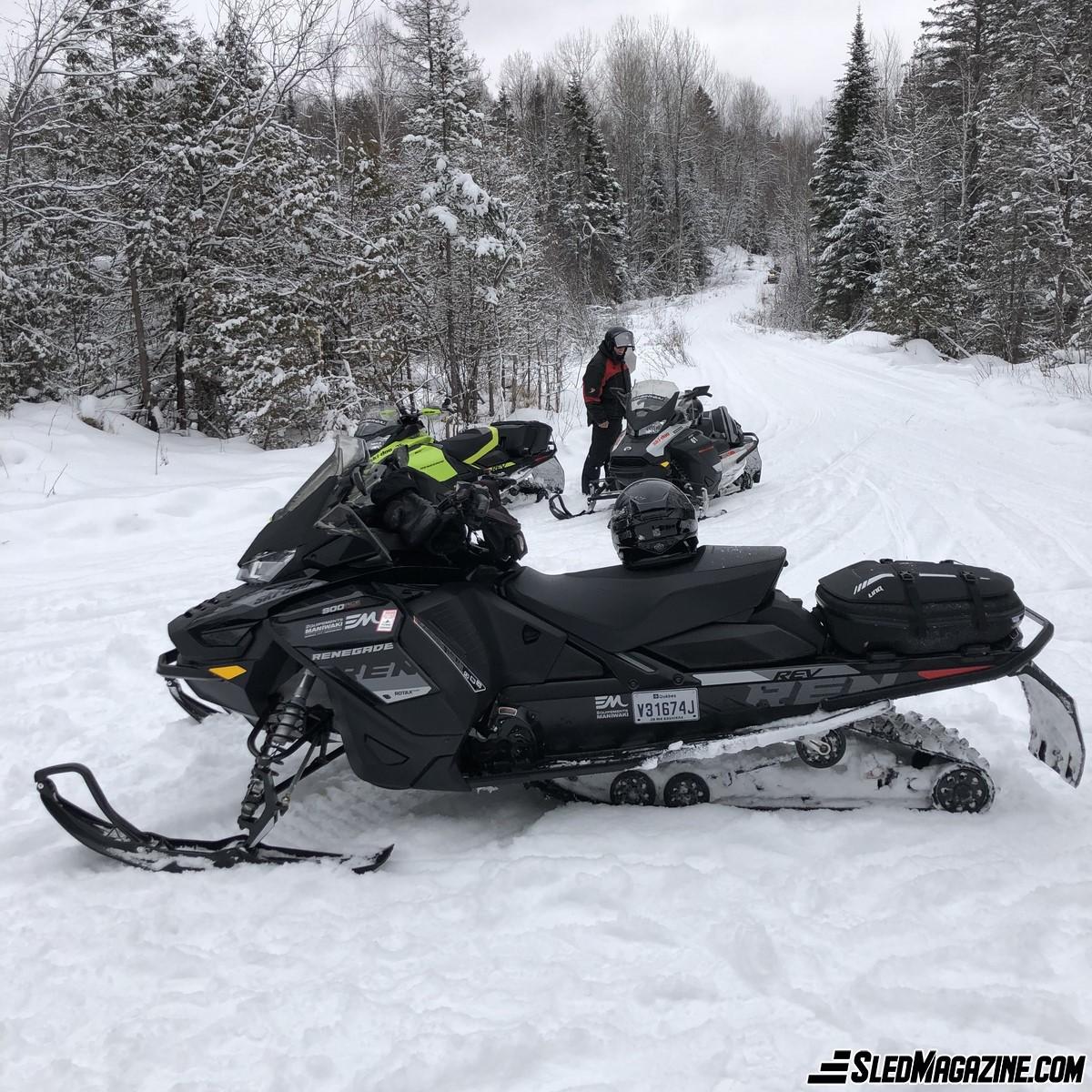Table of contents
Toggle- Look – General Appearance of the Snowmobile
- Finishing – Quality of Assembly of Materials and Parts
- Optional Accessories
- Manoeuvrability
- Driving Position
- Comfort – Seat, Steering Wheel Position, Possible Adjustment
- Engine (Sound, Emission, Vibration) and Exhaust System
- Acceleration/Engine Power
- Darting
- Suspension
- Track
- Reverse
- Cockpit
- Protection – Wind and Snow
- Storage
- Room for Improvement
My long-term trial of the Renegade 900 ACE Turbo is now complete, so I can give you a full picture of all the features of this snowmobile and how it handles on the trails.
As I mentioned in my previous articles, this snowmobile was hiding some secrets that I was eager to discover and unveil to you in this last article of the season, so here they are.
Look – General Appearance of the Snowmobile
When you look at this snowmobile alongside the other snowmobiles that are parked at a snowmobile pit stop, it’s obvious that it stands out from the crowd because of its streamlined chassis, its high-quality components and its technology. Its massive appearance gives the impression that it behaves well on trails.

Finishing – Quality of Assembly of Materials and Parts
Given the price of this snowmobile, the designers at BRP did not skimp on the quality of the finish to give it a hell of a look. Components such as the Gen4 chassis, HPG front shock, RAS 3/rMotion suspension, Intelligent Throttle Control (ITC) and the RipSaw track ensure that this snowmobile has all the components to make its owner feel confident and in control of his snowmobile during rides all while providing a great deal of satisfaction.


Optional Accessories
When I took possession of my snowmobile at Les Équipements Maniwaki, they placed SnowTrackers under my skis. This little addition is worth buying as it greatly improves driving and helps you negotiate curves with greater precision. What we notice on a BRP snowmobile is that with their skis, there is a bit of darting. It’s nothing big, and for some, it doesn’t bother them at all, while for others, there is always the option to have this add-on installed on the skis. It’s a purchase that is a plus for the snowmobile and its driver to avoid darting and have a better negotiation of bends.
For my travels, I purchased a 62 litre (3.765-cubic-inch) LinQ cargo box. With its rigid plastic design, it’s waterproof and safe… a must when travelling for several days. When the ride is over, or in the morning when departing, the box can be installed within seconds and removed as easily, with just a snap of the fingers. There is plenty of space inside to put our clothes or other miscellaneous items.
Manoeuvrability
The snowmobile, with its 4-stroke engine, makes it a little heavier than a 2-stroke. On the other hand, the narrow REV Gen4 chassis, which centralizes the mass, helps the driver perform maneuvers more easily, especially when negotiating curves or when encountering unexpected obstacles on the trail. It reacts quickly to the driver’s commands.
When riding off-trail, the snowmobile was surprisingly easy to maneuver and required little effort on my part. I must tell you, it surprised me for a 4-stroke.
Driving Position
The positioning of the driver on the REV Gen4 chassis is different from other chassis in the past. This platform responds very well to the driver’s commands both during acceleration and in aggressive turns. Even if it’s a new adaptation for the driver, I was, for my part, used to this chassis because, since its introduction, I’ve always driven a snowmobile with one. Driving for the rider must be more forward, making his maneuvers more direct and moving around more easily with little effort and a lot of ease.
Comfort – Seat, Steering Wheel Position, Possible Adjustment
The seat on this model is very comfortable. It has a wide and long cushion that allows the driver to move better and allows him to change position when fatigued. In addition, longer rides are most enjoyable.

The centrally adjusted handlebars give the driver very good control over his ride. In just a few minutes, the steering wheel can be adjusted to the position in which the driver feels most comfortable. However, an adjustment tool is mandatory.

Engine (Sound, Emission, Vibration) and Exhaust System
The Rotax 899 cc 3-cylinder turbocharged 4-stroke engine boosts its power to 150 horsepower and responds instantly during acceleration. The turbo has a sound that you can barely hear when you have your helmet on and is not unpleasant to your ears. In addition, it is barely perceptible to residents who are within 30 metres of a snowmobile trail.
Naturally, inside the passenger compartment, there’s an insulating layer that greatly reduces the intensity of the engine’s sound.


No more morning smoke shows when it’s time to warm up your engines. Nowadays, there’s almost no smoke, and even the scent on our clothes is almost non-existent.
Fuel consumption averages between 12 and 14 litres, depending, of course, on snow conditions, temperature and driving style.
Acceleration/Engine Power
The 900 ACE Turbo engine with 150 HP versus the 900 ACE with 90 HP is not comparable. It always depends on what the driver is looking for in a snowmobile, but rest assured that the turbo gave me a lot of thrills during acceleration. Note that the Intelligent Throttle Control (ITC) with three driving modes (Sport, Standard, ECO) provides a good choice in terms of the type of acceleration the driver prefers. In Sport mode, the engine is jumpy and responds immediately to the driver’s commands. The Standard mode, on the other hand, is less jumpy but responds well in a gradual manner. The ECO mode is the slowest to respond, which gives the driver a chance to adjust to the type of riding he prefers during the day and to the type of trails he is riding on during the day.
Darting
The Pilot 5.7 carbide skis show a slight darting, but this is not major. Perhaps BRP will eliminate this small inconvenience with the new X skis on the 2021 models.
Suspension
For this type of model, the manufacturer has placed high-quality shock absorbers and suspension that make it very maneuverable and comfortable in bumpy conditions and during long rides. This combination makes the driver a lot less fatigued at the end of the ride.


In addition to the HPG shock absorbers at the front and the RAS 3 suspension, which has already proven itself in the past with the unequal A-arm suspension, the manufacturers have placed the famous rMotion, which is, without a doubt, the latest generation suspension. It has proven its effectiveness on several models. That’s why this snowmobile was really designed to tackle trails in bad conditions and be more maneuverable for its driver.
Having covered several kilometres in one day with variable trail conditions, I can say today that the suspension and shock absorber package made the difference at the end of the ride on my physical condition.
Track
The RipSaw track has done a great job of meeting my expectations. A negative point with today’s climate change is that manufacturers should always lug their tracks as it increases stability on a hardened surface.

Reverse
The mechanical reverse system is easy, and there is no problem to put it in reverse mode.

Cockpit
For the gauge, both during the day and in the evening, it is easy for the driver to read the information on it. We can say that from the cockpit, just with a press of the finger, the driver is in full control of the accessories.


The rear-view mirrors are positioned so that the driver can see the snowmobiler following him very well. Note that rear-view mirrors are optional.

Protection – Wind and Snow
When the driver sits on the snowmobile, the windshield and side panels prevent the wind from blowing down on him, making cold days less difficult.
In deep snow, with the chassis and especially the ergonomics around the engine, the snow is evacuated on the side without the cockpit being submerged.
Storage
The changes of the last few years with the new chassis and the weight reduction has influenced the storage, which is almost nil on the present model. There’s a 7-litre/1.85-gallon rear storage box in the seat, which allowed me to store small accessories. At the front, there’s a small box between the handlebars and the windshield for inserting documents. That’s why I recommend a LinQ box.

Room for Improvement
As far as I am concerned, two points could be improved by the manufacturer. The first is the handlebar. With the quality of components and other accessories they placed on this snowmobile, an adjustable handlebar would have been a plus for the rider instead of taking a tool to adjust. The other point concerns the Pilot 5.7 skis. On a hardened trail, you notice some darting. It doesn’t change the quality of this snowmobile, but the manufacturer should look at this aspect for the next seasons … maybe for the 2021 model?
In closing, my season was wonderful, and I had a great time with the crossover Renegade. What I find important for snowmobile enthusiasts is that at today’s retail prices, it must provide owners with a great deal of satisfaction and pleasure when riding. I can tell you that I experienced this beautiful feeling, and I recommend this snowmobile without hesitation.
I would like to thank Les Équipements Maniwaki for allowing me to test drive a Ski-Doo BRP product. If you have any questions about this model, I am always available to answer them.
The voice of the snowmobilers wishes you a pleasant end of the season and see you next winter.


